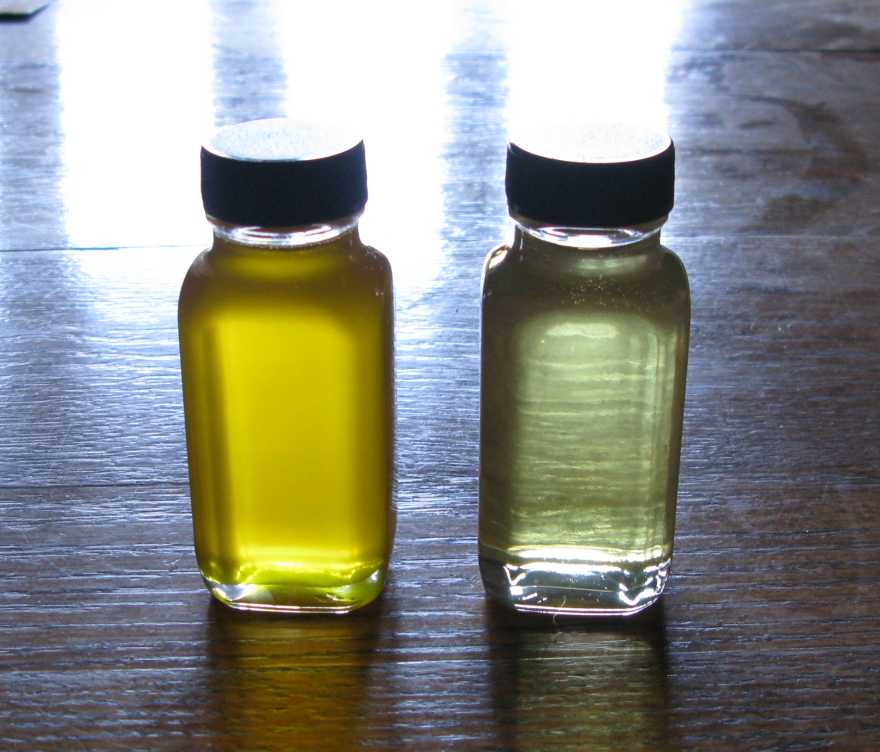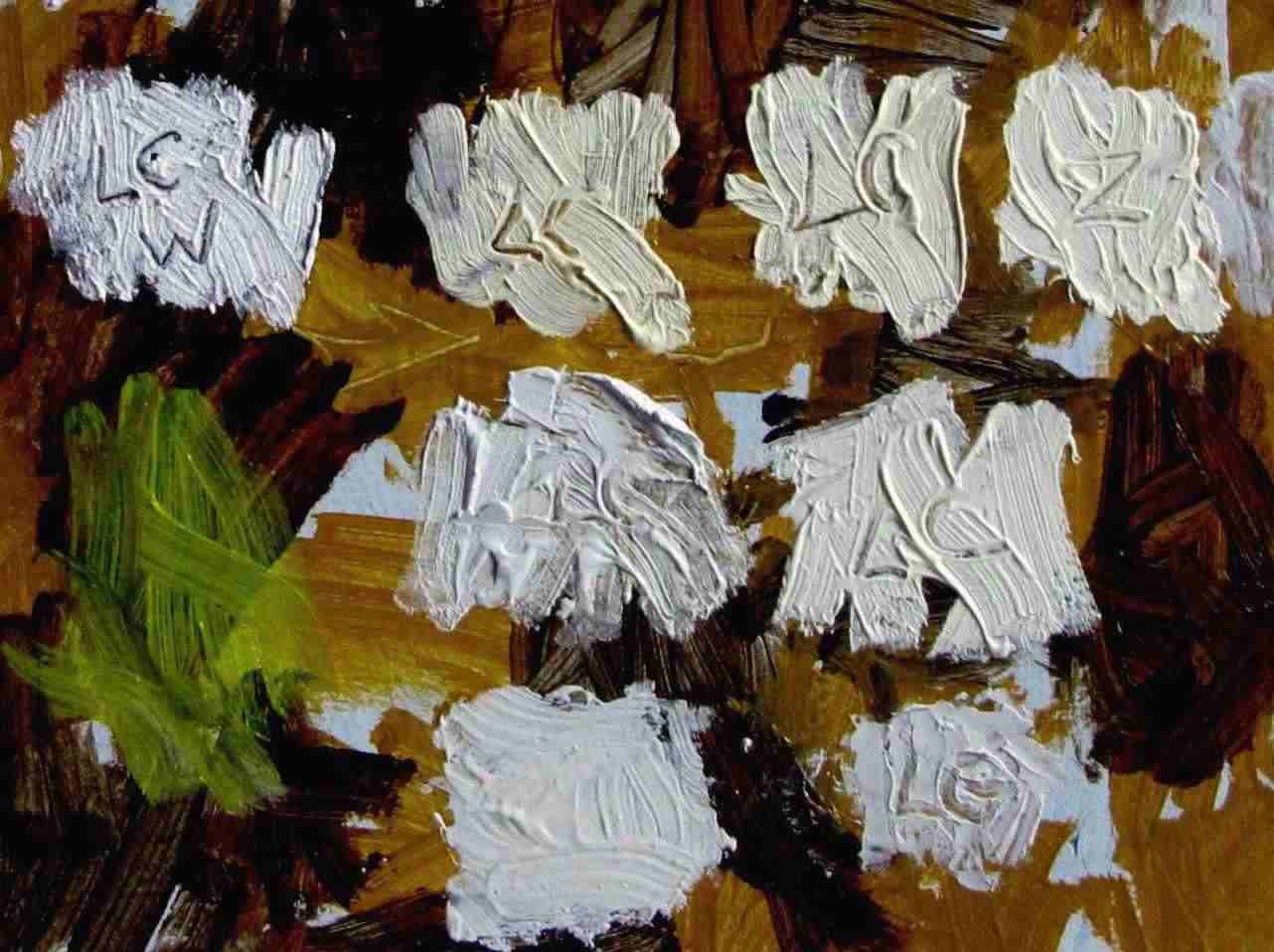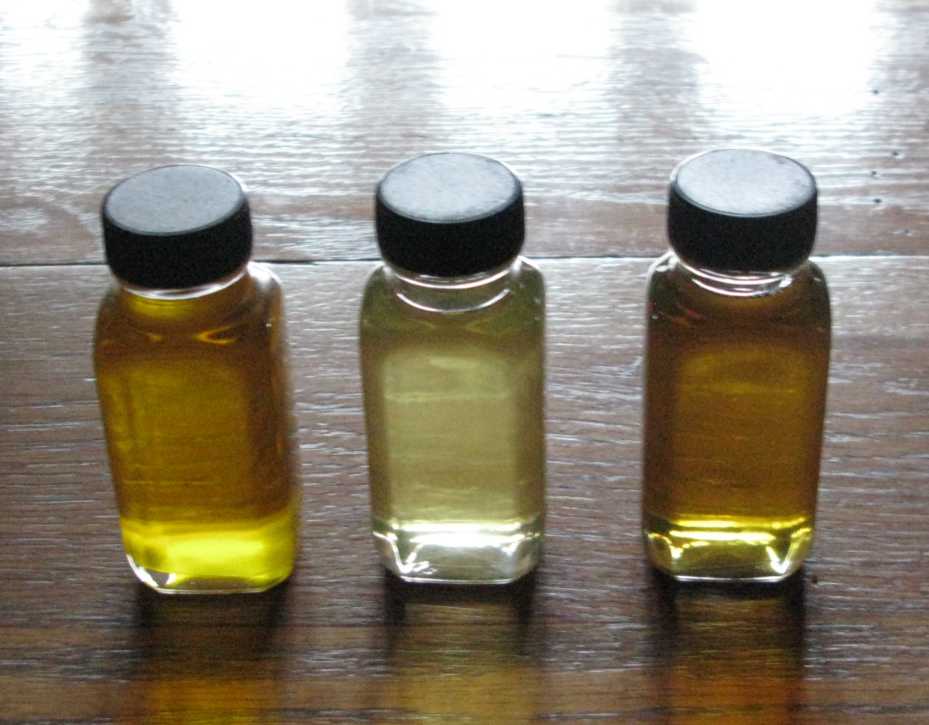
Flax/Linseed Oil ...and Yellowing
Flaxseed oil is derived from the flax plant, whose fibrous stalks were used since prehistoric times for weaving cordage and cloth. In fact the alternate name for flaxseed oil derives from the flax plant's primary use: Linen; and thus provides us the alternate name of linen seed oil. Flaxseed or Linseed oil is an edible so-called "drying oil" that has also been used by painters as a pigment-binder for more than a thousand years. After pressing from the flaxseed the raw and weak oil was typically either "sunned" or it was heat-processed so as to greatly increase its drying, adhesive, and water-resisting character (see Cennino Cennini, Dover Edition: "The Craftsman's Handbook"; Section on oil painting). For painting purposes, linseed oil was used mostly in Northern European countries, while walnut oil was favored within the South.
Many artists believe there is muscilage in linseed and other oils; and this contaminating matter causes the oil to be weaker, slower-drying and more yellowing than it should or could be. Thus they attempt to improve the oil by a "cleaning" process. Much has been written about "cleaning" traditional fixed drying oils. The process, also termed as "washing", involves various agents such as water or alcohols with additions of salt or other ingredients. The goal is to reach as much of a purified state as possible. While this "washing" does not make the oil any less yellow in its liquid appearance, an afterwards repose in sunlight can allow the oil to become bright and almost water-clear in appearance. Unfortunately this bright clarity of the liquid sunned linseed oil does not remain with the drying/solidifying of the washed oil; leastways not in my own experience. Upon reaching its cure-stage the yellowing returns, regardless; and it can be quite discoloring, especially with sallowing whites and blues that soon appear green.
However, some claim that with the correct washing procedure the oil actually does become non-yellowing after the cure-stage. As I have never witnessed this perfect state; I cannot personally vouch support of it. If you have read through my website under the heading of ORIGIN Congealed Varnish then you may be aware I am not a proponent of this 'contamination' theory. I believe the flaxseed oil is already nearly as pure as possible just as it comes from the maker; that it can certainly become clearer through settlement, but that washing it will accomplish nothing more than some loss of your total oil. Yes, my own view maintains any remaining matter within the pressed oil will slowly settle to the bottom. But beyond that I have seen no other benefit against yellowing. The oil yellows simply due to its inherent nature; and this 'nature' is determined according to the fixed linoleic and linolenic acid-ratios in its make-up. These relative ratios determine the extent of the yellowing. Science seems to support this notion; however, as far as I know, there remains great doubt among the steadfast proponents of "washing".
"Washing" painting oils is a time-consuming task typically taking months. Still, some painters insist their oils be washed before they will use them. As mentioned prior, a theory maintains that the darkening and sallowing tone of historical painting oils --especially linseed oil --arrives through contamination by muscilage from the seed husk occurring during the pressing from the seed --and especially so if heat is involved. Some also say the flaxseed or nut kernal-skin has an additional contaminate, an "albumenoid" matter that can also render yellowing. The noted A.P.Laurie was one who supported the theory of contaminents within the painting oils causing possible mischief. See: "The Painter's Methods and Materials" 1960, for example. Laurie termed these contaminants "muscilaginous and albumenoid" materials (page 40). In his book Laurie points to olden washing methods, which he concludes were performed to reduce the drying-time and improve the binding-power of linseed and nut oils. He profers that washing might also lead to less-darkening of the paint. I will add that a recent researcher took up the experimental study of washing oils to 'settle the matter' (pun intended) of whether the old practice actually improved the oils. Unfortunately, as regards the notion of muscilage being present within the oil, a careful reading to the end of the paper reveals there was no actual testing performed showing muscilage to be present in the sloughed-off gook collected via "washing". Though fully intending to do so, the researcher admits simply forgetting to test the settled-out gook. Read it here: http://dare.uva.nl/cgi/arno/show.cgi?fid=453682]
I will admit that on its face, the theory of contamination during oil-production seems reasonable; and yet I have never found any support from my own trials. I will keep an open mind, though. I am not too old to learn things.
But again, I have found no indication of any "albumenoid" and/or "muscilaginous" contaminents within those oils I trialed myself. Some oils that became quite acidic and less oxidative took a long time to reach their cured yellowing-stage, but eventually that stage did ensue ...and yellowing occurred; and it seemed just as bad as the parent oil. Honestly, even if a slight trace of Laurie's M&A could be found, there is no evidence that such matter would even cause a yellowing of the oil. I mean, after all, muscilage derived from linseed is not known to tarnish when hidden away in a dark closet or closed up in a drawer; and so it must follow that if muscilage were indeed present within the oil then why would it alter the coloration?
Less-Yellowing Linseed Oils
The "washing" trials and argument aside, something rather curious about linseed oil has revealed itself through many years of trials. It is this: The inherent yellowing of cured linseed or nut oils can be reduced almost completely through a high-temperature heating process. This revelation may not surprise everyone, as some will know that true heat-processed linseed "standoil" yellows much less that raw linseed oil. Stand oil is claimed to be linseed oil that has been cooked at about 570 F. for an extended period while remaining within an atmosphere of carbon dioxide which allays oxidative-degradation. The problems with standoil involve its exceedingly high viscosity, its inability to hold the stroke (levels and slumps), and its slow-drying and long-tack-free time. Thus, as a straight addition to oil paints, standoil behaves badly, causing brush-drag --essentially needing a solvent to help paint-application; as well as a siccative to improve its curing. Of course, nothing will overcome the enamel-like flow it induces.
But I am not referring to standoil herein. Again, standoil is extremely thick in viscosity, while the linseed oils I'm announcing are thin. I will share with you that the simple heating of the oil in a certain manner can produce in minutes what washing cannot do in months (if at all?). Amazingly, a freshly-extracted or cloudy and dingy-yellow flaxseed oil can, within an hours-time, be made nearly water-clear in appearance without the sun!
As example to my contention, here is an image showing fresh, cloudy and perfectly edible flaxseed oil on the left. On the right is that same flaxseed oil as it appears after being heated to a very high temperature:

Quite a difference, yes? It boggles the mind. And to add, there was no sunning required to lose the coloring.
Now, some sleuths (like Laurie) would postulate that the freshly-pressed flaxseed oil contained all sorts of muscilaginous and albumenoid matter; but if so then what happened to that contaminating matter? Even the original cloudiness has disappeared. I will share that the flaxseed oil was only heated --there were no additions and no filtering, at all. To my own mind it would seem that heating any sort of "muscilaginous or albumenoid" matter would cause that to darken and embrown the oil. Yet there is no such appearance; and in fact the oil has become nearly colorless in its liquid state (and it's permanently that way). Re-stating myself, the cloudy flaxseed oil was merely poured into a proper cooker and heated to a very high temperature.
This heat-processed linseed oil has some other attributes: It now exhibits a higher gloss as well as an amazing 'wetting ability' when mixed with pigments to create oil paint --much better than the freshly-pressed oil. This heat-processed and still low-viscosity linseed oil produces good upstanding paint that does not level as would happen with the use of standoil. Additionally, the paint created dries-to-touch in three-days. The downside? Well, unfortunately, this processed oil still yellows considerably after drying -- though not as much as the fresh oil. That noted, I quickly found that if the oil is put through the hi-heat process a second time, then it becomes no more yellowing than walnut oil.
I call this double-cooked flaxseed oil "Heat-Processed Linseed Oil"; and I now use it in the formulation of various historical mediums and varnishes I offer to painters --such as my 19th Century Copal Painting Medium. As far as I have found, this linseed oil is unique to my own limited manufacture; there is nothing like it available elsewhere.
Another finding: If the flaxseed oil is heated even higher, to a point where it physically boils, it becomes thickened and essentially remains non-yellowing when dried. I call this physically-boiled flaxseed oil "Heat-polymerized Linseed Oil". It mirrors the Heat-Polymerized Walnut Oil that I have produced since the early 90's. [60 mil. bottle of either the linseed or the walnut HPO is $16.50] Both of these oils are also unique to my own limited manufacture.
A simple demonstration of how these new linseed oils perform
In the following image I show samples of white paint aged over several months in a poorly lighted room (though not a dark room). I have chosen to create most of the samples with basic lead carbonate as the pigment. Know that all samples have a nice gloss upon their surface, indicating the presence of a healthy extant coating of the linseed oil. The reason I insist on the gloss is that a dull paint surface will weaken the visual effect incurred by the oil's eventual discoloration. I will share that an old trick for using common linseed oil in blue skies and whites was to use ample solvent for brushing it on. The solvent chased the linseed oil down into the paint while it rose to the surface and evaporated away. As there was very little linseed oil extant upon the surface of the blue or white paint, there would be only a faint yellowing. Also be aware that lead carbonate will show the inherent yellowing nature of drying oils sooner and stronger than any other white. If you think you have a non-yellowing oil, rub-up some lead white pigment with it then place your sample in a dimly-lit room or closet and await a week or month. Lead pigment will decide the argument.]

The sample showing at the top (far left) is freshly-rubbed-up lead white made by mixing basic lead carbonate (denoted by "LC") with regular walnut oil. The sample has not dried and shows its pristine whitness which will eventually become a faint yellow-ish tinge -- not as much as linseed oil, though. Solidification must occur before the tinge develops. I supply this sample to show just how bright freshly conjured lead white can be; however, and again, once the paint solidifies, the yellowing will show. All the other samples have dried and aged for 4-months, which is essentially the limit of the yellowing that will occur within the next 25-plus years. If the samples were kept in a normally day-lit room, less yellowing would be observed.
The second sample is lead carbonate mixed with the original freshly-made flaxseed oil. This is the cloudy yellow stuff shown in the previous image (left bottle). Some will argue this oil contains Laurie's "albumenoid and muscilagenous matter".
The third image over is the heat-processed and nearly water-clear flaxseed oil. Very interestingly, the sample is noticeably less-yellowed than the raw untreated oil.
The fourth sample is the same heat-processed and nearly water clear linseed oil but now mixed with zinc oxide. The camera has failed to record much difference between the zinc and the lead samples-- but trust me, the zinc is rather whiter to my eyes as I view the samples. [Did you know Zinc oxide fights the yellowing of oils?]
Second row down shows lead carbonate rubbed-up with flaxseed oil that has been heat-processed twice. A drop of siccatif de Countrai was added to the second sample (right) and it shows slightly more yellowing, though the sample dried firm overnight; and so that seems a good trade-off for my usual fast-drying needs. Anyway, do notice the second hi-temp heat-processing of the flaxseed oil has now reduced the yellowing even more. In fact, after this second heating the flaxseed oil exhibits no more yellowing than a decent unrefined walnut oil. The oil still dries glossy in about three days; Also, it still wets pigment easily and still allows a fair retention of brushstrokes.
I believe this double heat-processed linseed is a truly superior oil for painting, which is why I have now begun using it in certain painting mediums of my own creation. [For instance, I'm now using this heat-processed oil in my reproduction of the typical 19th Century Copal Painting medium.]
The bottom layer, left sample, shows my Heat-Polymerized Linseed Oil rubbed-up with lead carbonate then given a drop of Siccatif de Courtrai so that it dried overnight. Even after 4-months the lead carbonate-based sample is close in appearance to the freshly-made and still wet walnut oil sample at far left, top; however the glossy brushstroke shows that a leveling and enamel-like character has now become prevalent. The sample at far right is ORIGIN Congealed Varnish constructed with this heat-polymerized linseed oil instead of the heat-polymerized walnut oil that I have used for more than a decade. Again, there is virtually no yellowing.
So ... what has happened here? Why has heating freshly-expressed and cloudy linseed oil somehow allowed it to become essentially clear and non-yellowing in normal room lighting? Have I mysteriously caused the supposed "albumenoid and muscilagenous matter" to disappear through fumation; or were there no such things in the oil to start with? Perhaps I have merely altered the fatty-acid ratios, driving certain elements from the oil, leading to increased pigment-wettability, and this has had a strange effect on what I can only assume is a chemical yellowing ...? Me, I will have to presume the later, for, repeating myself, I would have to believe that heating muscilage and albumen --if these matters were present --would have caused a carbonization of those elements at the extremely high temperatures involved in processing this flaxseed oil. Yet the heat-processed oil became clearer and brighter rather than darker.

The image above shows the relative appearances between ordinary linseed oil and my high-temperature processed linseed oils. The first bottle on the left is the original flaxseed oil as it left the supplier. Its initial cloudiness has now settled to the bottom. This is just common every day edible organic linseed oil with no stabilizers. It dries in about 5-days when rubbed-up with lead carbonate.
The middle bottle is my nearly colorless double-heat-processed linseed oil, which requires about 3-days to become solidified when making lead white paint. Repeating myself, this processed linseed oil yellows no more than a fine raw walnut oil.
The third bottle (right) is my heat-polymerized linseed oil. This is the original physically boiled oil mentioned in the olden books and manuscripts (such as Cennini's handbook). I offer this oil as well as a walnut oil version to oil painters on this website. both these oils provide similaities to modern day "standoil". though they are created without the CO2 atmosphere and at a much higher temperature than commercial standoil. This oil takes about a week to dry because its more oxidative elements have been fumed-off. These oils are thicker than regular oil, but with a much-thinner viscosity than commercial standoil, allowing each to be easily used without the need of a solvent.
I will mention that the apparent coloration of these heat-processed linseed oils will not alter if stored in darkness. I have long preferred and advancd the use of nut oil with oil painting; however, I am quite impressed by these heat-processed linseed oils.
BTW, one of the truly grand attributes of using heat-processed or heat-polymerized linseed oil is how soon it becomes tack-free. By comparison, walnut oil can remain tacky for a very long time.
James C. Groves, February, 2016
Click here to visit our Gallery page.